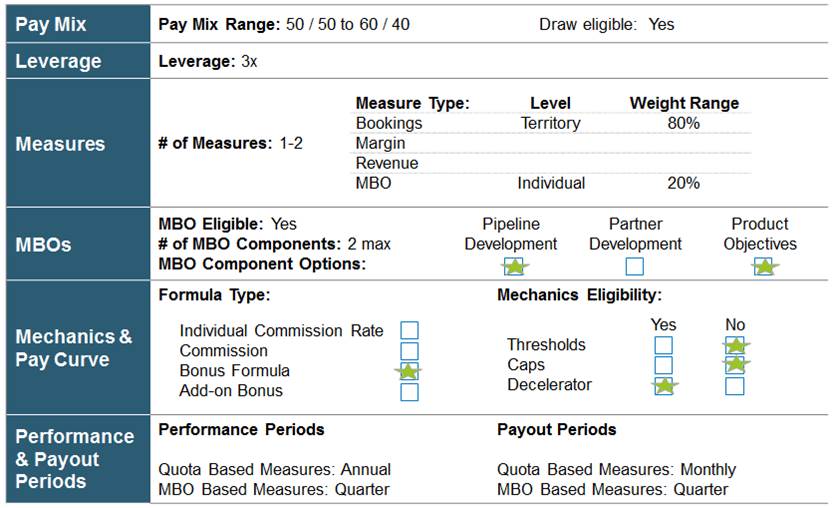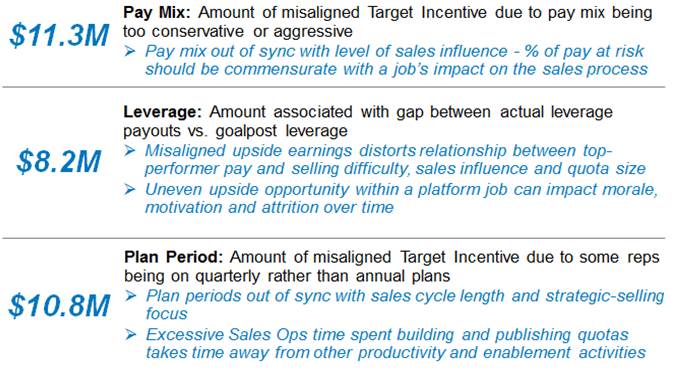Create Design Goalposts to Manage Sales Comp Plan Consistency

Salespeople in the same role should all be on the same sales compensation plan, right? You may be surprised to hear that many companies, particularly ones with large sales forces that span the globe, struggle to manage the desired level of consistency in plan designs for the same role across the company.
A Wide Spread Problem. Consider a recent example where the sales compensation executive was analyzing sales compensation plans for the company’s primary selling role, the territory sales representative. Here is what she found:
- Pay mix ranged from 40/60 to 70/30
- Some territory sales reps had one bookings measure while others had 5 separate MBOs
- Territory sales reps in Europe had 2x accelerators and capped plans while reps in the US had 3x accelerators and no caps
Sales leaders and HR executives regularly find themselves in this situation as the result of a decentralized plan design process. Region leaders are given autonomy to make decisions often with limited governance and oversight from headquarters. The end result: 1) not all plans align to the desired behaviors of the job, 2) incumbents in the same sales job have unequal earnings potential, and 3) measuring plan effectiveness for that job just got a lot harder.
Plan Design Goalposts. Companies with best-in-class sales compensation programs avoid this situation by establishing a concrete set of goalposts to guide the development of sales compensation plans globally. The definition of goalposts is simple: a set of design parameters for all components of a company’s sales incentive plan. For plans to be approved, the designs must pass through goalposts for each element ranging from pay mix to crediting rules. While the definition is simple, the creation of goalposts is not. Many stakeholders, whether they reside in HR, Sales, Finance or Operations, often have different opinions as to what the ideal sales compensation plan should look like. Sometimes these opinions, in fact more than opinions – beliefs and philosophies – are difficult to reconcile. Consider how commonly Finance and Sales argue over commission accelerators! Finance wants to manage costs while Sales wants to maximize rewards for over-performers. Yet more importantly, even within the Sales organization there is often disagreement among different sales leaders based upon their histories, experiences and varying philosophies on sales compensation design.
Plan design goalposts are a great way to get your company’s sales compensation program under control. The benefits of plan design goalposts are many:
- Sales job and sales compensation plan alignment 95%+ of the time
- Greater plan consistency and fewer plan exceptions
- Saved time and manpower through a faster and more efficient incentive design process
- Balance between centralized control and local need flexibility
- Greater ability to evaluate plan effectiveness by role
Getting Started. To best start the journey it pays to be prepared. Have a clear plan and process that involves the right stakeholders so you can avoid (or at least minimize) the amount of conflict and headaches along the way.
Step 1: Design Goalposts. Make sure to involve sales, finance, operations, HR groups and other key stakeholders. Get people in a room and hash things out. Involve representatives from different regions to see where local market practices require unique treatment. Having a consistent set of sales platform jobs will significantly simplify this process, preventing confusion between job titles and the work people are actually performing. If platform jobs are critically out of date or do not exist, do this work first. Next, as a team, work through the sales compensation goalpost decisions by job family, and secure agreement on appropriate sales compensation goalposts for each job. Keep iterating goalpost design until executive level agreement is reached. The end result should look something like this:
Example Goalpost Composite

Step 2: Conduct a Goalpost Alignment Test. Step two involves evaluating current incumbent plans against the newly designed goalposts. Collect sales compensation plan designs for all incumbents in each sales role. This information should include target pay mix, measures, mechanics, and any other pertinent plan design components. Next, match every incumbent to the appropriate platform job and compare the actual plan designs to the platform job goalposts to determine the gaps. Compile the individual gaps into cumulative results. Don’t be surprised to see some big numbers! Gap tests regularly show hundreds of incumbents and / or millions of Target Incentive dollars outside established goalposts.
Example Goalpost Analysis

Step 3: Update Plans to Align With Goalposts. To do this step you might have to first gain executive approval to overhaul the misaligned plans. Incentive misalignment exists at most companies but the magnitude of the problem varies and is often hidden from management. Associating numbers with the problem (as shown above) is a great way to get management’s attention. Millions of incentive dollars may be at risk and desired selling behaviors could be compromised by earning potential inequality and dilution of focus. Gaps like these can ultimately lead to ineffective performance, misspent sales compensation dollars and attrition.
Step 4: Transition to New Plans. The final step requires careful transition planning so you can implement new plans that are aligned to your goalposts. While the short-term transition process may be difficult, the long-term benefits are compelling. With good goalposts in place, you now have a menu of plan options and mandates that can direct incentive design decisions for several years to come, saving lots of time and energy, not to mention fewer disputes and change requests landing on your desk!
Do you believe your company has misaligned sales compensation plans? Contact us to learn how we can help.
Designing Goalposts is an important step toward building a center of excellence for sales compensation program management. We will take up the subject of the other two steps in subsequent posts: a) Defining and Establishing Sales Compensation Guiding Principles, and b) Establishing Platform Jobs.